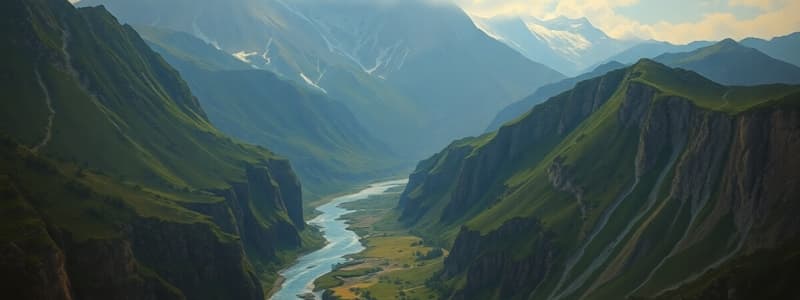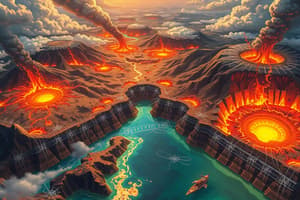Podcast
Questions and Answers
What geological process describes the creation of new seafloor material from molten material?
What geological process describes the creation of new seafloor material from molten material?
- Transform faulting
- Subduction
- Convergence
- Divergence (correct)
Where is younger oceanic crust typically located?
Where is younger oceanic crust typically located?
- Near subduction zones
- Along oceanic ridges (correct)
- Within deep ocean trenches
- At continental margins
What results from the collision between oceanic and continental crust?
What results from the collision between oceanic and continental crust?
- Rift valley development
- Continental uplift
- Oceanic trench
- Volcanic arc formation (correct)
What geological feature is formed by two tectonic plates sliding past each other?
What geological feature is formed by two tectonic plates sliding past each other?
Which boundary type is least likely to exhibit slab pull?
Which boundary type is least likely to exhibit slab pull?
What is the primary characteristic of divergent plate boundaries?
What is the primary characteristic of divergent plate boundaries?
What happens during oceanic-continental convergence?
What happens during oceanic-continental convergence?
Which type of plate boundary is characterized by two plates sliding horizontally past one another?
Which type of plate boundary is characterized by two plates sliding horizontally past one another?
What type of boundary occurs when two continental crusts collide?
What type of boundary occurs when two continental crusts collide?
What geological feature is most likely to form at a divergent boundary?
What geological feature is most likely to form at a divergent boundary?
During oceanic-oceanic convergence, what happens to the denser crust?
During oceanic-oceanic convergence, what happens to the denser crust?
Which of the following correctly describes the movement of plates at convergent boundaries?
Which of the following correctly describes the movement of plates at convergent boundaries?
Which plate boundary type is involved in the creation of new oceanic crust?
Which plate boundary type is involved in the creation of new oceanic crust?
Flashcards
Divergent Boundary
Divergent Boundary
A plate boundary where two plates move apart, causing molten material to rise.
Convergent Boundary
Convergent Boundary
A plate boundary where two plates move towards each other creating different types.
Oceanic-Continental Convergence
Oceanic-Continental Convergence
A type of convergent boundary where oceanic crust slides under continental crust.
Oceanic-Oceanic Convergence
Oceanic-Oceanic Convergence
Signup and view all the flashcards
Continental-Continental Convergence
Continental-Continental Convergence
Signup and view all the flashcards
Transform Boundary
Transform Boundary
Signup and view all the flashcards
New Seafloor Creation
New Seafloor Creation
Signup and view all the flashcards
Youngest Oceanic Crust
Youngest Oceanic Crust
Signup and view all the flashcards
Continental Volcanic Arc Formation
Continental Volcanic Arc Formation
Signup and view all the flashcards
San Andreas Fault Type
San Andreas Fault Type
Signup and view all the flashcards
Slab Pull Location
Slab Pull Location
Signup and view all the flashcards
Study Notes
Seafloor Spreading
- Seafloor spreading is the process of creating new oceanic crust from molten material.
- This process occurs at mid-ocean ridges where magma rises from the Earth's mantle and cools, forming new crust.
- The further away from the mid-ocean ridge, the older the oceanic crust.
Location of Young Oceanic Crust
- Younger oceanic crust is typically located near mid-ocean ridges.
- This is because the process of seafloor spreading constantly creates new crust at these locations.
Oceanic-Continental Convergence
- When oceanic and continental crust collide, the denser oceanic crust subducts beneath the continental crust.
- This process results in the formation of volcanoes, earthquakes, and mountain ranges along the coastlines.
Transform Plate Boundary
- A transform plate boundary is formed when two tectonic plates slide past each other horizontally.
- These boundaries are characterized by frequent earthquakes and lack of volcanic activity.
Slab Pull
- Slab pull refers to the force of gravity pulling the denser oceanic plate down into the mantle at a subduction zone.
- Transform plate boundaries are least likely to exhibit slab pull because there is no subduction occurring.
Divergent Plate Boundary
- The primary characteristic of divergent plate boundaries is the creation of new crust.
- This occurs as magma rises from the mantle and cools, forming new crust.
Oceanic Oceanic Convergence
- During oceanic-oceanic convergence, the denser oceanic plate subducts beneath the less dense plate.
- This process results in the formation of volcanic island arcs and deep trenches.
Transform Boundary
- A transform boundary is characterized by two plates sliding horizontally past one another.
- There is no creation or destruction of crust at this boundary.
Continental-Continental Convergence
- When two continental crusts collide, they are too buoyant to subduct.
- This results in the formation of mountain ranges through folding and uplift.
Divergent Boundary
- Mid-ocean ridges are the most common geological feature formed at a divergent boundary.
- These ridges represent the zone where new oceanic crust is created.
Oceanic-Oceanic Convergence
- During oceanic-oceanic convergence, the denser plate subducts beneath the less dense plate.
- This process causes the denser plate to melt, producing magma that rises and erupts to form volcanic island arcs.
Convergent Boundary Movements
- Convergent boundaries are characterized by the collision of tectonic plates.
- The denser plate subducts beneath the less dense plate, resulting in volcanic activity, earthquakes, and mountain formation.
Oceanic Crust Formation
- Divergent boundaries are responsible for the creation of new oceanic crust.
- This occurs through the process of seafloor spreading, where magma rises from the mantle and cools, forming new crust.
Studying That Suits You
Use AI to generate personalized quizzes and flashcards to suit your learning preferences.




